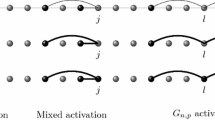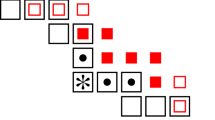Abstract
A bootstrap percolation process on a graph \(G\) is an “infection” process which evolves in rounds. Initially, there is a subset of infected nodes and in each subsequent round each uninfected node which has at least \(r\) infected neighbours becomes infected and remains so forever. The parameter \(r\ge 2\) is fixed. Such processes have been used as models for the spread of ideas or trends within a network of individuals. We analyse this process in the case where the underlying graph is an inhomogeneous random graph, which exhibits a power-law degree distribution, and initially there are \(a(n)\) randomly infected nodes. The main focus of this paper is the number of vertices that will have been infected by the end of the process. The main result of this work is that if the degree sequence of the random graph follows a power law with exponent \(\beta \), where \(2 < \beta < 3\), then a sublinear number of initially infected vertices is enough to spread the infection over a linear fraction of the nodes of the random graph, with high probability. More specifically, we determine explicitly a critical function \(a_c(n)\) such that \(a_c(n) = o(n)\) with the following property. Assuming that \(n\) is the number of vertices of the underlying random graph, if \(a(n) \ll a_c(n)\), then the process does not evolve at all, with high probability as \(n\) grows, whereas if \(a(n)\gg a_c(n)\), then there is a constant \(\varepsilon > 0\) such that, with high probability, the final set of infected vertices has size at least \(\varepsilon n\). This behaviour is in sharp contrast with the case where the underlying graph is a \(G(n, p)\) random graph with \(p=d/n\). It follows from an observation of Balogh and Bollobás that in this case if the number of initially infected vertices is sublinear, then there is lack of evolution of the process. It turns out that when the maximum degree is \(o(n^{1/(\beta - 1)})\), then \(a_c(n)\) depends also on \(r\). But when the maximum degree is \(\Theta (n^{1/(\beta - 1)})\), then \(a_c (n) = n^{\beta - 2 \over \beta - 1}\).
Similar content being viewed by others
References
Adler, J., Lev, U.: Bootstrap percolation: visualizations and applications. Braz. J. Phys. 33(3), 641–644 (2003)
Albert, R., Barabási, A.: Statistical mechanics of complex networks. Rev. Mod. Phys. 74(1), 47–97 (2002)
Amini, H.: Bootstrap percolation and diffusion in random graphs with given vertex degrees. Electron. J. Combin. 17, R25 (2010)
Amini, H.: Bootstrap percolation in living neural networks. J. Stat. Phys. 141, 459–475 (2010)
Balogh, J., Bollobás, B.: Bootstrap percolation on the hypercube. Probab. theory relat. field 134(4), 624–648 (2006)
Balogh, J., Pittel, B.G.: Bootstrap percolation on the random regular graph. Random Struct. Algor. 30(1–2), 257–286 (2007)
Balogh, J., Peres, Y., Pete, G.: Bootstrap percolation on infinite trees and non-amenable groups. Comb. Probab. Comput. 15(5), 715–730 (2006)
Balogh, J., Bollobás, B., Morris, R.: Bootstrap percolation in three dimensions. Ann. Prob. 37, 1329–1380 (2009)
Balogh, J., Bollobás, B., Duminil-Copin, H., Morris, R.: The sharp threshold for bootstrap percolation in all dimensions. Trans. A. Math. Soc. 36, 2667–2701 (2012)
Bollobás, B.: Random Graphs. Cambridge studies in advanced mathematics. 2nd edn, vol. 73, pp. xviii+498. Cambridge University Press, Cambridge (2001)
Bollobás, B., Janson, S., Riordan, O.: The phase transition in inhomogeneous random graphs. Random Struct. Algor. 31(1), 3–122 (2007)
Cerf, R., Manzo, F.: The threshold regime of finite volume bootstrap percolation. Stoch. Process Appl. 101(1), 69–82 (2002)
Chalupa, J., Leath, P.L., Reich, G.R.: Bootstrap percolation on a Bethe lattice. J. Phys. C 12, L31–L35 (1979)
Chung, F., Lu, L.: Connected components in random graphs with given expected degree sequences. Ann. Comb. 6, 125–145 (2002)
Chung, F., Lu, L.: The average distance in a random graph with given expected degrees. Internet Math. 1(1), 91–113 (2003)
Chung, F., Lu, L., Vu, V.: The spectra of random graphs with given expected degrees. Internet Math. 1(3), 257–275 (2004)
Faloutsos, M., Faloutsos, P., Faloutsos, C.: On power-law relationships of the internet topology. ACM SIGCOMM Comput. Commun. Rev. 29(4), 251–262 (1999)
Fontes, L., Schonmann, R.: Bootstrap percolation on homogeneous trees has 2 phase transitions. J. Stat. Phys. 132, 839–861 (2008)
Fontes, L.R., Schonmann, R.H., Sidoravicius, V.: Stretched exponential fixation in stochastic Ising models at zero temperature. Comm. Math. Phys. 228, 495–518 (2002)
Gilbert, E.N.: Random graphs. Ann. Math. Stat. 30, 1141–1144 (1959)
Holroyd, A.E.: Sharp metastability threshold for two-dimensional bootstrap percolation. Prob. Theory Rel. Fields 125(2), 195–224 (2003)
Janson, S., Łuczak, T., Ruciński, A.: Random graphs. Discrete Mathematics and Optimization. Wiley-Interscience, New York (2000)
Janson, S., Łuczak, T., Turova, T., Vallier, T.: Bootstrap percolation on the random graph \({G}_{n, p}\). Ann. Appl. Probab. 22(5), 1989–2047 (2012)
Jeong, H., Tombor, B., Albert, R., Oltvai, Z.N., Barabasi, A.L.: The large-scale organization of metabolic networks. Nature 407(6804), 651–654 (2000)
Kumar, R., Raghavan, P., Rajagopalan. S., Tomkins, A.: Extracting large scale knowledge bases from the web. In: Proceedings of the 25th VLDB Conference, 639–650, 1999
Sabhapandit, S., Dhar, D., Shukla, P.: Hysteresis in the random-field Ising model and bootstrap percolation. Phys. Rev. Lett. 88(19), 197202 (2002)
Sausset, F., Toninelli, C., Biroli, G., Tarjus, G.: Bootstrap percolation and kinetically constrained models on hyperbolic lattices. J. Stat. Phys. 138, 411–430 (2010)
Söderberg, B.: General formalism for inhomogeneous random graphs. Phys. Rev. E 66, 066121 (2002)
Tlusty, T., Eckmann, J.P.: Remarks on bootstrap percolation in metric networks. J. Phys. A 42, 205004 (2009)
Toninelli, C., Biroli, G., Fisher, D.S.: Jamming percolation and glass transitions in lattice models. Phys. Rev. Lett. 96(3), 035702 (2006)
van der Hofstad, R.: Random Graphs and Complex Networks. (2011) www.win.tue.nl/rhofstad/NotesRGCN2011.pdf
Acknowledgments
We would like to thank Rob Morris for pointing out an oversight in an earlier version of this paper. We are also grateful to the anonymous referees for valuable comments and suggestions to improve the presentation of the paper. Hamed Amini gratefully acknowledges financial support from the Austrian Science Fund (FWF) though project P21709. Nikolaos Fountoulakis’s research has been supported by a Marie Curie Intra-European Research Fellowship PIEF-GA-2009-255115 hosted by the Max-Planck-Institut für Informatik.
Author information
Authors and Affiliations
Corresponding author
Rights and permissions
About this article
Cite this article
Amini, H., Fountoulakis, N. Bootstrap Percolation in Power-Law Random Graphs. J Stat Phys 155, 72–92 (2014). https://doi.org/10.1007/s10955-014-0946-6
Received:
Accepted:
Published:
Issue Date:
DOI: https://doi.org/10.1007/s10955-014-0946-6




